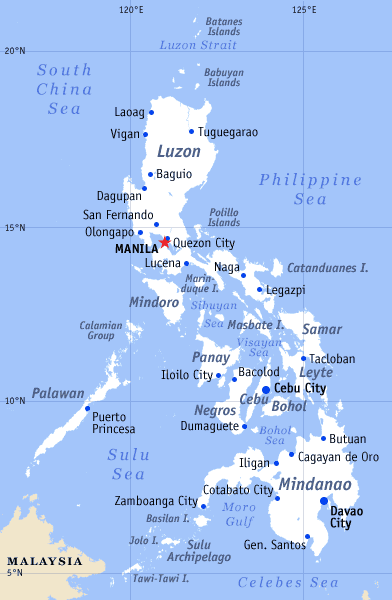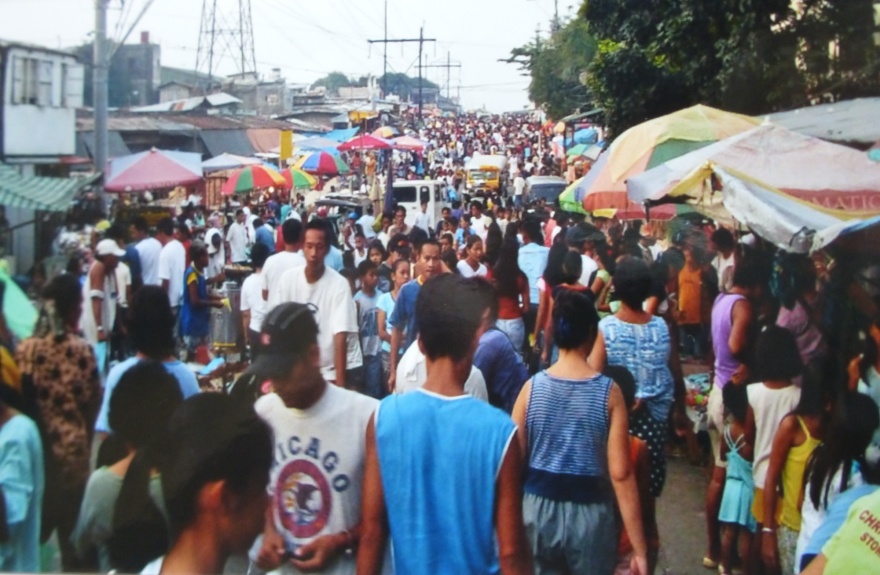A brief introduction to the Philippines
Geography
Located between the South China Sea and the Pacific Ocean on the same latitude as Ethiopia. 7,000 islands, 2,000 of which are inhabited. Total area 300,000 km² (120,000 sqare miles; Germany: 356,000 km²/140,000 sq mi).
The islands are divided into four groups:
the
Northern
Isles with Luzon, Mindoro, and others;
the
Southern
with Mindanao, the Sulu islands, and others;
the
central (Visayas)
with Panay, Negros, Leyte, Bohol, and Cebu;
and in the
Southwest
the long island of Palawan, which is surrounded by 1,700 smaller islands.
History
First settlements via the land bridge from Asia that existed until about 5,000 years ago. Subsequent settlements by Malays with outriggers.
From 1380 AD on the Islam gains more and more currency, originating from Borneo and the Sulu Archipelago. Ferdinand Magellan usurps the islands for Spain in 1521; they are named after King Philipp II in 1542.
Christian crusades follow in subsequent years, sparing only the Muslim South.
At the end of the 19th century, movements for independence led by Jose Rizal and Andreas Bonifacio are squelched with violence.
Following a spanish-american war, the Philippines are surrendered to the USA in 1898. Under US government, infrastructure, but also military bases are built.
1941 through 1944, military oppression by Japan.
Independence on 4 July 1946.
1965, president Ferdinand Marcos, from 1972 under martial law. Dictatorial powers since 1973. Suppression of oppositional groups such as the communist New People Army and the Muslim group Moros on the Sulu islands and parts of Mindanao. Following a peaceful riot (People Power), Marcos escapes into Hawaiian exile in 1986.
The American military bases were shut down following the eruption of the Pinatubo in 1991. Indigenous, communist and islamist groups still cause riots occasionally. The current president is Rodrigo Duterte (since June 2016). The former mayor of Davao (Mindanao island) is notorious for his relentless and violent fight against drug-related crime.
Population and society
107 million inhabitants (2015), 300 per km² (Germany: 240). 25 % are between 17 and 25 years old. 83 % are Catholics, 4,5% non-Catholic Christians, 5 % Muslims. The Catholic Church has a strong influence on politics and society, despite constitutional laicism. 170 languages and dialects. Millions of Philippinos work and live abroad as crew, domestic workers, nurses. The money that they send back to their families amounts to 10 % of the gross dometic product. Individual income has remained stable over time despite an increase in GDP, owing to inflation and the growing population. In 2000, about 40 % had to get by with less than 2 USD per day. The legal minimum wage is about 5 EUR, but is often not enforced.
Families are large and live closely together. There is strong loyalty between family members. Elders are much respected. This may explain why the few rich families cater to themselves predominantly. Inspite of their extreme poverty, people are remarkably happy, tolerant, and hospitable.
Bahala na
Environment and climate
Tropical climate with average temperatures around 26 °C (79 °F). Humidity is high. It rains frequently; the rain period with tropical storms from the Southwest is from July through November. Relatively cool Northeastern monsoon from December through March. Due to the location on the Pacific Ring of Fire earthquakes and volcanic eruptions are not uncommon. Deforestation, erosion, waste dumping and air and water pollution take a heavy toll on the environment. Infrastructure is severely lacking.

